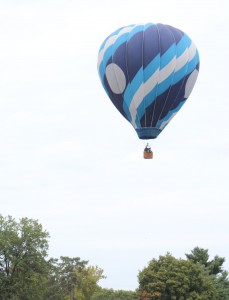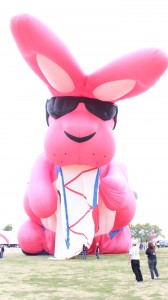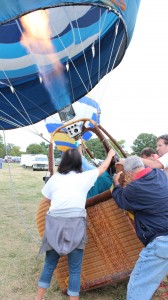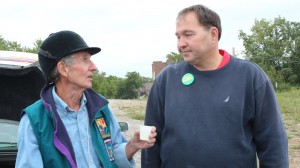As the wind picks up, balloon pilot John Esserman huddles with other two other pilots; all three talk in serious tones. Today is the 39th annual Great Forest Park Balloon Race, the most well-attended, single-day hot air balloon race in the United States, and the sky is a deep gray overhead. For each of the 62 pilots here today, the chief concern is the weather. The light breeze on the ground could be treacherous in the air, and the sky is only getting darker.

After conferring with several other pilots, John rejoins his seven person balloon crew. He makes an announcement.
“I may or may not fly today. It’s the pilot’s option. There are thunderstorms pretty close today.”
John says he will wait until the pilot’s briefing, which has been moved up due to the weather, to decide whether or not to fly.
For now, John and the crew must wait.
Over 30 years ago, John got his start in ballooning at the Great Forest Park Balloon Race. He attended the race as a spectator, and he was inspired to start his own ballooning career. He began crewing for other pilots, and eventually, John took a ballooning course at Meramec Community College and received his pilot’s license. In 1981, John bought his first balloon.
Despite the weather, John’s crew talks, snacks and laughs in lawn chairs set up next to a white car with a license plate reading BALLON. Attached to the car is a blue trailer plastered with bumper stickers. This trailer holds John’s balloon, the Crystal Ball.
John bought the Crystal Ball’s balloon envelope in 1996 for $15,000. He already had the basket and burner, but he was in need of a new envelope after his old one wore out. A friend paid for the new envelope, so long as John flew the balloon at the friend’s company events. Thus, the Crystal Ball, John’s third balloon, was born.
Next to the Crystal Ball crew, the black-shirted Bunny Crew begins to lay out a large, pink balloon. This is the Energizer Bunny. Energizer sponsors the Great Forest Park Balloon Race, and the Bunny always plays the role of the hare in the race. The hare is the first balloon to take off. While up in the air, this balloon drops an X. The wind currents dictate where the X will be dropped. It is the goal of the other pilots to drop a weighted baggie on the X or as close to the X as possible.

The Bunny begins to inflate, and John and a couple crew members head over to the pilots tent for the briefing.
At the tent, other pilots fill in rows of chairs. While some exchange friendly banter, many are somber and serious. At this meeting, the pilots will receive weather updates crucial to their decision whether or not to fly.
For John, a hint of bad weather could stop him from flying. Though he always wants to fly, he is cautious when making decisions. While no pilot flies in thunderstorms or extreme wind, John also chooses not the fly in rain. He prefers to be safe rather than sorry.
Once all the pilots have filled in the chairs, with many standing in back, the briefing begins.
“We are trying to move everything up,” race head John Marlow says. “The weather’s coming in. You can fly, but you don’t have to fly. There is no pressure on you either way.”
Marlow steps aside, and another man gives a weather report. He starts calling out numbers detailing weather conditions at various altitudes.
“One twenty-five feet, 180 at six.”
“Sixteen hundred, 160 at 16.”
“Thirty-seven hundred feet…well, don’t fly that high.”
The pilots laugh, but the mood remains serious. These numbers are crucial. While a pilot can’t steer a balloon, he or she does have some control over speed and direction by flying at different altitudes. The sky is layered, and by moving between the layers, a pilot can master the balloon’s movement.
After the weather report, Marlow takes charge again and announces a change in plans. The race will go on, but the Bunny may not fly. Today, flying is a concern for any balloon, but it is especially troubling for an oddly shaped balloon, such as the Bunny. While wind moves around traditionally-shaped balloons, unusual shapes and sizes are prone to tilting in the wind.
The meeting parts with one final warning. Be safe.
John rejoins the two crew members who listened-in outside the tent. He is still undecided.
“This is the hardest part of flying,” John says. “Flying is easy. Deciding whether or not to fly is the hard part when the weather is borderline.”
Last year, John and the other pilots faced this same decision. At the 2010 race, the wind kept several pilots on the ground.
“The winds were weird,” John said. “The air currents spun us around. It was a very difficult flight.”
Another year, high winds canceled the race. In 1983, wind speeds of 9 mph caused the race to be canceled. At today’s race, the winds are blowing at 6 mph. This is not be fast enough to cancel the race, but it does cause the pilots to worry.
John and his crew members walk back across the launch field to join the rest of the crew. All around, other pilots discuss the weather in worried tones.
The Crystal Ball crew confers, and other crews do the same. Even though the Bunny is almost totally inflated, the other pilots and crews do nothing. They all wait for someone else to make the first move.
After a few minutes of waiting and watching, two things happen simultaneously. Two pilots start to lay out their balloons. And it is announced the the Bunny is not going up. The Fox 2 balloon will be the hare instead.
Weighing these factors, John makes a decision. He is going up.
With this, a flurry of activity begins. The crew starts unrolling the envelope, a huge mass of blue and white fabric, and inflating the balloon using a fan. All around them, other balloons begin inflating and taking off, abandoning the set protocol of going up in three distinct waves. With each new balloon that takes off, the 130,000 spectators surrounding the launch field cheer.
In a matter of minutes, the Crystal Ball is inflated, a billowing mass of blue fabric on the ground. John attaches the balloon to the basket. It is time to go. Igniting the burner, John and his passenger, Humane Society downer Bill Couch, hop in the basket.

Because hot air rises, the flames push the balloon into the air. John and Bill are off.
“Bye everybody,” John calls to his huddle of crew members on the ground.
The crew yells back as the crowd cheers.
“Bye, happy Forest Park Balloon Race 2011.”
***
As John sails through the air and over the treeline, his crew springs into action. They rapidly pack up the trailer. Half of the crew jumps into the car, and the other half pushes through the crowd, scrambles down a hill and crams into a car parked some distance away. The chase is on.
The role of the chase crew is an imperative one. They have to be at the landing site when the balloon begins to come down in order to help the pilot land safely. If they arrive a few seconds too late, the pilot faces the challenge of landing without ground assistance.
Driving the car, crew member Eric Martens slugs through the park congested with people and parked cars. Four balloons have already landed due to the wind, and spectators gather around them.
From the confines of the car, the crew scours the skies, looking for the Crystal Ball.
Eric and his wife Laurel Martens joined the Crystal Ball balloon crew years ago, when Laurel and and John’s wife Marilyn Esserman became friends through work. Neither had any prior experience with ballooning, but they both enjoy the social atmosphere of crewing.
“It’s fun crewing with us,” Laurel said. “We are a colorful crew.”
Eric turns north out of the park. Laurel sits in the passenger seat, trying to reach John over a radio.
“Crystal Ball, where are you at?”
No response.
Suddenly, a cell phone rings. It is Marilyn, calling from the other chase car. Laurel answers the phone.
“He’s at Page?”
Eric turns, recalculating his course to reach the balloon.
“There he is,” Laurel points. Sure enough, way in the distance, is a blue balloon with a distinctive gray circle.
Eric picks up the chase, rushing to reach the Crystal Ball the second it lands. He ignores a red light, speeds down the streets and slams on the brakes to avoid hitting a car stopped at a stop sign.
Once again, the crew loses sight of John and the balloon. Laurel, frustrated with the unresponsive radio, tries calling John’s cell phone. Surprisingly, it works.
“John, where are you at, this is Laurel….Okay, I see you up there.”
She hangs up.
“He wants us to go back to Ogden.”
Eric turns around the car and takes off in that direction.
“I’ve got him,” crew member Jim Neal shouts. Sure enough, there is the blue balloon, so close as it nears the ground to land.
Unfortunately, the street running along the field where John has chosen to land is blocked off by a large tow truck.
This does not stop Eric; he flies over the curb, barely slowing to yell to the tow truck driver that yes, he is with the balloons. Eric pulls the car into park along the side of the road, and the crew runs to the field. The other chase car is already here, helping John land the balloon. Neighborhood kids stand around, watching the action. It’s barely been 30 minutes since the Crystal Ball took off, and the race is already over.
***
The crew tracks through the tall grass, approaching John and Bill, who stand next to the deflated balloon. While John never got close enough to drop his baggie, he and his passenger are still happy they got to go up in the air.
“I loved it,” Bill said. “It was unbelievable. I was praying we wouldn’t tip, and I wouldn’t fall out.”
John and Bill recall their adventure to the crew, the most exciting moment being when John attempted to land and instead was swept into a grove of trees, picking up a branch on the way. Luckily, the balloon was not harmed.
The race may be over, but there is still excitement in the air as the crew begins to pack up the balloon at John’s direction. Once everything is loaded back onto the trailer, John pops open a bottle of champagne.
In an tradition as old as ballooning itself, John pours cups for himself and his passenger and proposes a toast called the Balloonists’ Prayer.

“The winds have welcomed you with softness. The Sun has blessed you with his warm hands. You have flown so high and so well that God has joined you in your laughter and set you gently back again into the loving arms of Mother Earth.”
And with that, John pours the cup of champagne over Bill’s head.
Bill is surprised, and he laughs along with the crew. While they know they did not win, victory is still in the air. There is another toast; this time, everyone is given a cup of champagne, and they toast to good fortune, today’s weather forgotten, already looking ahead to their next flight.
“The best thing is the companionship between the balloonist and the crew,” John said. “What I’ve said for years is that a hot air balloon ride is simply an excuse to have a party when you land. I still fly because of that. When you land, people don’t care if you are a passenger or the pilot. Everyone associated is a balloonist.”










